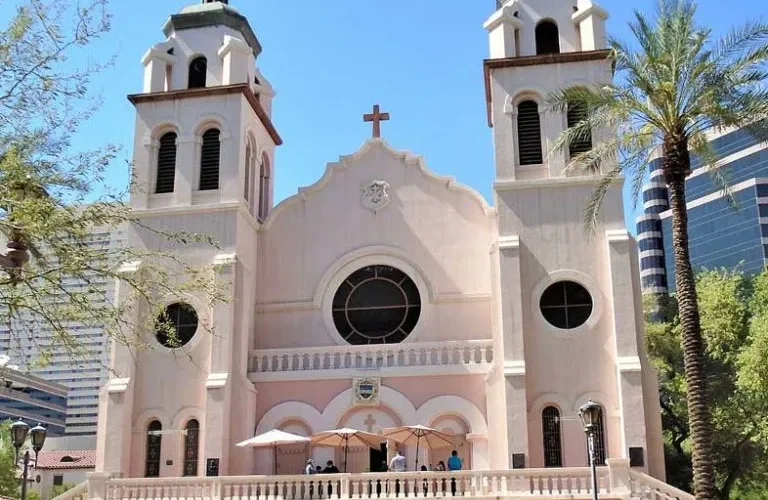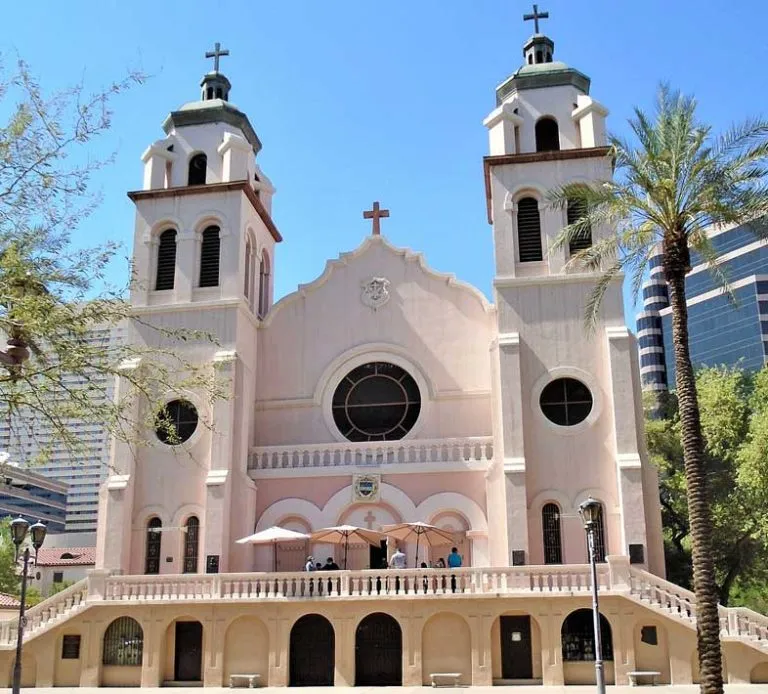
Introduction
Saint Mary’s Basilica – officially The Church of the Immaculate Conception of the Blessed Virgin Mary – is a church of the Roman Catholic Diocese of Phoenix located at 231 North 3rd Street at the corner of East Monroe Street in downtown Phoenix, Arizona, United States. It was built from 1902 to 1914 in a combination of the Mission Revival and Spanish Colonial Revival styles, and was dedicated in 1915.
It replaced an earlier adobe church built in 1881 when the parish was founded. The parish has been staffed by the Franciscan Friars since 1895. The current church was elevated to a minor basilica by Pope John Paul II in 1985. St. Mary’s Basilica is a parish of the Franciscan friars of the Province of Saint Barbara. The first Franciscan came to the area in 1539.
The oldest Roman Catholic parish church in the greater Phoenix area, St. Mary’s was the only parish in Phoenix until 1924 and is home to Arizona’s largest stained glass windows collection and a 26 rank pipe organ built by the Schantz Organ Company. The building was added to the National Register of Historic Places in 1978 as “St. Mary’s Church”.
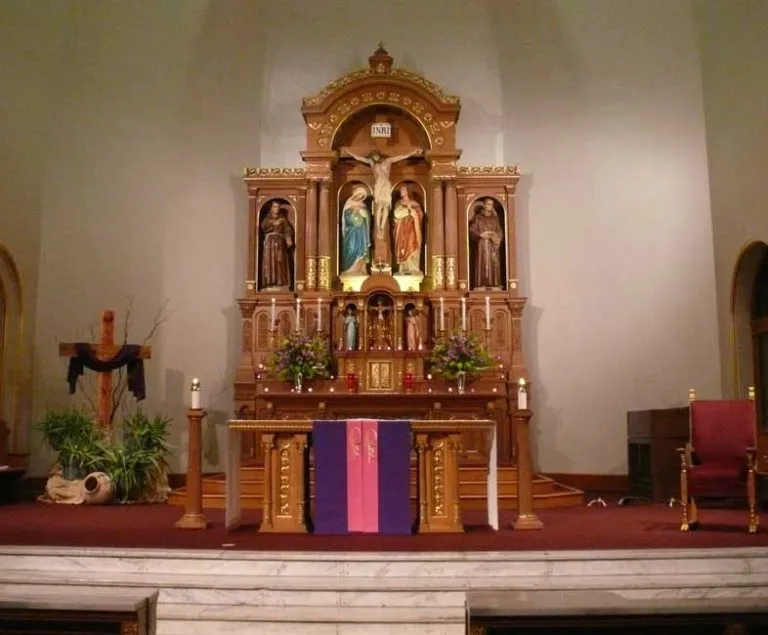
History of Saint Mary's Basilica, Phoenix
The Church of the Immaculate Conception of the Blessed Virgin Mary (St. Mary’s Basilica) is the oldest Catholic parish in Phoenix and was the only Catholic parish in Phoenix until 1924. It is the second oldest church in Phoenix with the First Presbyterian Church, organized in 1879, being the oldest. The beginnings of St. Mary’s looked to the private residence of Mr. Jesus Otero located at First Avenue and Washington Street. From 1872 until 1881 priests from Florence, Arizona traveled by buggy every three months, to conduct the Catholic liturgy.
Construction of a church on the present site of Third and Monroe Streets began in 1880 under the supervision of Rev. Edouard Gerard. Rev. Gerard was the first priest ordained (February 2, 1877) in Arizona. The church was built of adobe, with a steeple pitched, shingled roof. With its completion, the church was dedicated by Bishop Salpointe on June 24, 1881. Rev. Joseph Bloise, the first resident priest, came in 1825. His successor, Rev. Francois X. Jouvenceau, came in 1887.
In December 1895, at the invitation of Bishop Peter Bourgade, the Franciscan Friars agreed to accept responsibility for the church the arrangement was signed by Rev. Michael Richardt, Provincial of the Sacred Heart Province headquartered in St. Louis. Rome insured Franciscan permanence in Phoenix by granting the Beneplacitum Apostolicum (papal approval) on January 7, 1896: The first friars arrived on January 12, 1896.
By 1902 the adobe church was in need of major repairs and enlargement. The current pastor, Fr. Novatus Benzing, O.F.M., received permission from his superiors to proceed with construction of a new church. The new church would need to be constructed in two phases due to budget constraints.
The adobe church was razed and construction began on the basement which would serve as the “basement church” until the upper church could be completed. The architect was Adrian Wewer, O.F.M., assisted by Leonard Darched, O.F.M. The local architects were R.A. Gray and George Gallagher. The “basement church” (now the social hall) was dedicated on February 11, 1903 under the patronage of the Immaculate Heart of the Blessed Virgin Mary by His Excellency Bishop Henri Granjon of Tuscon.
The second phase of construction began in July 1913. The construction contract was awarded to W. J. Rifley. The church was constructed in the Mission Revival style and is considered to be an outstanding example of Mission Revival style. The interior is in the Romanesque style.
On September 6, 1976, St. Mary’s was named an historic site by the Arizona Historical Society. On October 17, 1977, the church was added to the State Inventory of Historic Places of Arizona. St. Mary’s was placed on the National Register of Historic Places on November 29, 1978. On September 2, 1985, His Holiness Pope Saint John Paul II solemnly proclaimed the church of the Immaculate Conception of the Blessed Virgin Mary to be a Minor Basilica.
While on his American visit, His Holiness John Paul II (now Pope Saint John Paul II) visited St. Mary’s kneeling in prayer in the center aisle and speaking to the crowd from the balcony on September 14, 1987. The people of Phoenix voted St. Mary’s as a “Point of Pride” in the city in 1993.
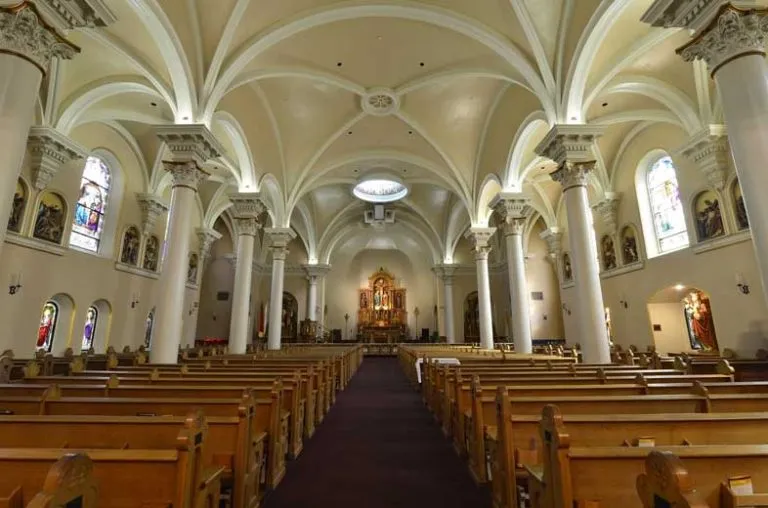
Architecture
Architectural Styles : Mission Revival architecture, Spanish Colonial Revival architecture.
The church’s Mission Revival–Spanish Colonial Revival structure supports four domes spanning the length of the Basilica. All the domes are compound design with the pendentives, following Roman architecture, transferring the weight of the roof to the pillars. The dome over the intercept point of the crossover, the nave center aisle and the apse, is topped with stained glass and features a lantern above the dome to emit light into the nave and sanctuary.
The dome located over the altar is topped with a cupola designed to provide light to the altar. The two bell towers are topped with onion shaped domes, typical of the churches of Bavaria and Austria, where Fr. Novatus Benzing, the Pastor at the time, and Leonard Darscheid, the Architectural Consultant, both originated. The towers house four bells which ring daily. The renowned Gothic-style stained glass collection was manufactured by the Emil Frei Studio of Missouri.
The large upper windows depict scenes from the life of the Blessed Virgin Mary, while the lower nave and transept windows depict images of popular Saints of the Franciscan Order and of the heritage of the cultures represented in the community at the time (German, Spanish, Irish). Also noteworthy are the Stations of the Cross by the Andrew Kaletta Studio of St Louis. Rather than simply being painted, they are cast in high relief on a gold background which causes the figures and their detailed features to stand out prominently.
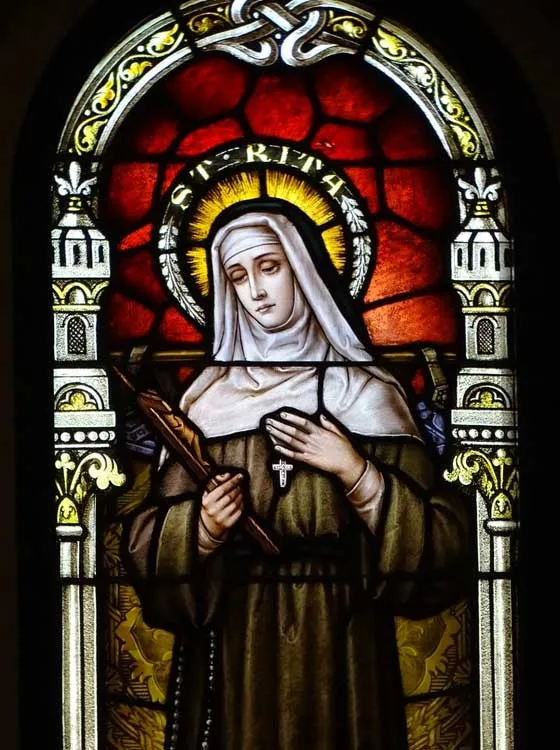
Minor Basilica
Pope John Paul II elevated Saint Mary’s to the rank of a minor basilica in 1985, two years before his visit to Phoenix in 1987, when he visited St. Mary’s and addressed crowds of thousands from the balcony on the facade.
The principal symbols of its status as a Basilica – the Tintinnabulum (large bell on a column) and the Ombrellone (large gold and red umbrella) – are displayed in the sanctuary.
Saint Mary’s became the 32nd basilica in the United States and remains the only basilica in Arizona. The church, a Phoenix Points of Pride, is located at the northeast corner of North 3rd Street and Monroe in downtown Phoenix, a carillon of the Copper Square.
Liturgy and Worship
Saint Mary’s Basilica is an active parish church and center of worship for the Diocese of Phoenix. It is known for maintaining a traditional form of liturgy featuring the pipe organ, choir, men’s scholar and a wide range of music from traditional Gregorian chant to Renaissance polyphony and contemporary composers in its services.
Masses are celebrated from Monday to Friday at Noon, beginning with the singing of the Angelus, and on Sundays at 5:00 pm (Saturday Vigil), 9:00 am and 11:00 am. Solemn Choral Vespers are also celebrated on Sunday evenings at 5:00 pm during the seasons of Advent and Lent. St. Mary’s also holds Devotions to Saint Anthony of Padua on Tuesdays after the noon Mass, and Exposition of the Blessed Sacrament on Thursdays after the noon Mass, concluding with Benediction at 2:00 pm.
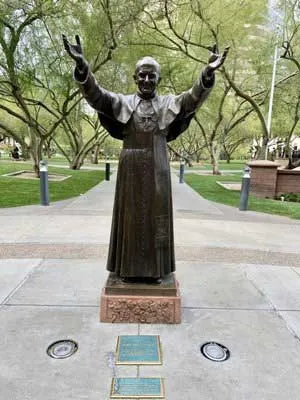
Feast Day – 8th September
A Novena is held on the first nine days from 29 August to 7 September. September 8, the day on which Mother Mary was born, is celebrated as a Holy feast.
Mass Time
Weekdays
Saturdays
Sundays
Church Visiting Time
Gift Shop
The church in its wisdom has a beautiful Gift Shop.
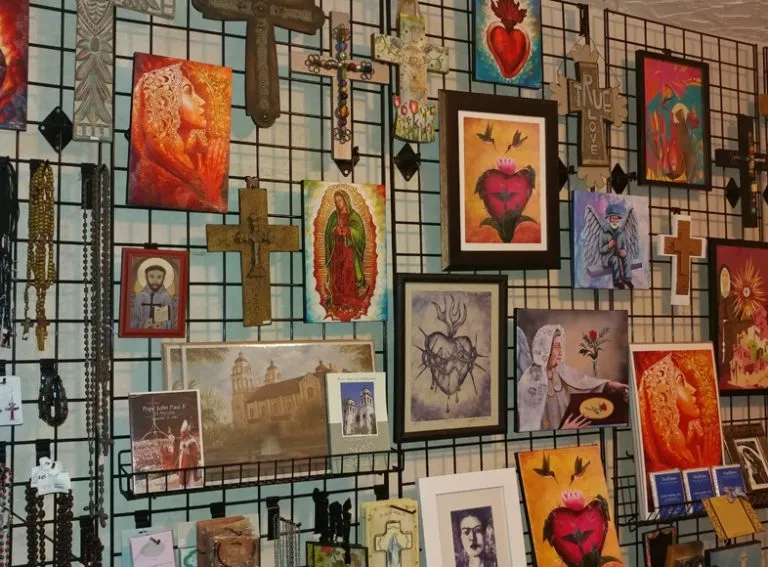
Contact Info
231 N 3rd St, Phoenix,
AZ 85004, Arizona, United States
Phone No.
Tel : +1 602-354-2100
Accommodations
How to reach the Basilica
Phoenix Sky Harbor International Airport in Phoenix, Arizona, United States is the nearby airport to the Basilica.
Van Buren – Central Ave Light Rail Station in Phoenix, Arizona, United States is the nearby Train Station to the Basilica.

